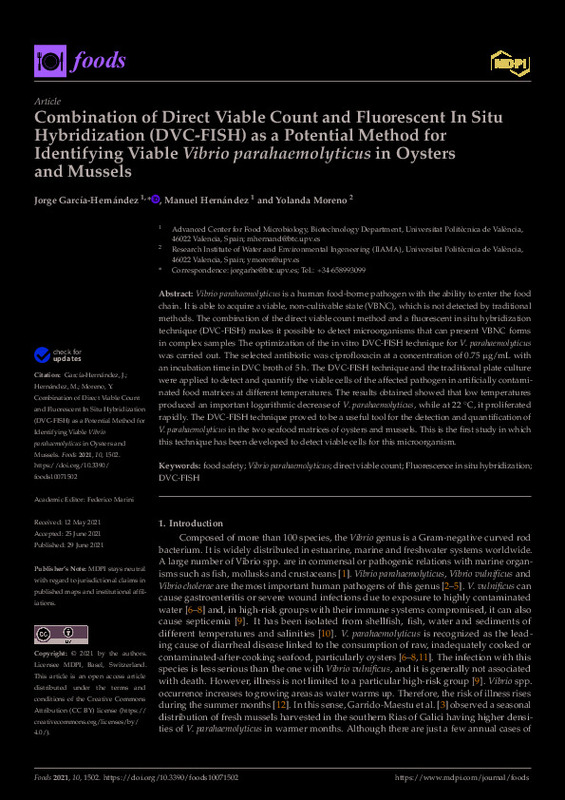JavaScript is disabled for your browser. Some features of this site may not work without it.
Buscar en RiuNet
Listar
Mi cuenta
Estadísticas
Ayuda RiuNet
Admin. UPV
Combination of Direct Viable Count and Fluorescent In Situ Hybridization (DVC-FISH) as a Potential Method for Identifying Viable Vibrio parahaemolyticus in Oysters and Mussels
Mostrar el registro sencillo del ítem
Ficheros en el ítem
| dc.contributor.author | García Hernández, Jorge
|
es_ES |
| dc.contributor.author | Hernández Pérez, Manuel
|
es_ES |
| dc.contributor.author | Moreno Trigos, Mª Yolanda
|
es_ES |
| dc.date.accessioned | 2022-06-13T18:05:04Z | |
| dc.date.available | 2022-06-13T18:05:04Z | |
| dc.date.issued | 2021-07 | es_ES |
| dc.identifier.issn | 2304-8158 | es_ES |
| dc.identifier.uri | http://hdl.handle.net/10251/183245 | |
| dc.description.abstract | [EN] Vibrio parahaemolyticus is a human food-borne pathogen with the ability to enter the food chain. It is able to acquire a viable, non-cultivable state (VBNC), which is not detected by traditional methods. The combination of the direct viable count method and a fluorescent in situ hybridization technique (DVC-FISH) makes it possible to detect microorganisms that can present VBNC forms in complex samples The optimization of the in vitro DVC-FISH technique for V. parahaemolyticus was carried out. The selected antibiotic was ciprofloxacin at a concentration of 0.75 mu g/mL with an incubation time in DVC broth of 5 h. The DVC-FISH technique and the traditional plate culture were applied to detect and quantify the viable cells of the affected pathogen in artificially contaminated food matrices at different temperatures. The results obtained showed that low temperatures produced an important logarithmic decrease of V. parahaemolyticus, while at 22 degrees C, it proliferated rapidly. The DVC-FISH technique proved to be a useful tool for the detection and quantification of V. parahaemolyticus in the two seafood matrices of oysters and mussels. This is the first study in which this technique has been developed to detect viable cells for this microorganism. | es_ES |
| dc.language | Inglés | es_ES |
| dc.publisher | MDPI AG | es_ES |
| dc.relation.ispartof | Foods | es_ES |
| dc.rights | Reconocimiento (by) | es_ES |
| dc.subject | Food safety | es_ES |
| dc.subject | Vibrio parahaemolyticus | es_ES |
| dc.subject | Direct viable count | es_ES |
| dc.subject | Fluorescence in situ hybridization | es_ES |
| dc.subject | DVC-FISH | es_ES |
| dc.subject.classification | MICROBIOLOGIA | es_ES |
| dc.title | Combination of Direct Viable Count and Fluorescent In Situ Hybridization (DVC-FISH) as a Potential Method for Identifying Viable Vibrio parahaemolyticus in Oysters and Mussels | es_ES |
| dc.type | Artículo | es_ES |
| dc.identifier.doi | 10.3390/foods10071502 | es_ES |
| dc.rights.accessRights | Abierto | es_ES |
| dc.contributor.affiliation | Universitat Politècnica de València. Departamento de Biotecnología - Departament de Biotecnologia | es_ES |
| dc.contributor.affiliation | Universitat Politècnica de València. Instituto Universitario de Ingeniería del Agua y del Medio Ambiente - Institut Universitari d'Enginyeria de l'Aigua i Medi Ambient | es_ES |
| dc.description.bibliographicCitation | García Hernández, J.; Hernández Pérez, M.; Moreno Trigos, MY. (2021). Combination of Direct Viable Count and Fluorescent In Situ Hybridization (DVC-FISH) as a Potential Method for Identifying Viable Vibrio parahaemolyticus in Oysters and Mussels. Foods. 10(7):1-14. https://doi.org/10.3390/foods10071502 | es_ES |
| dc.description.accrualMethod | S | es_ES |
| dc.relation.publisherversion | https://doi.org/10.3390/foods10071502 | es_ES |
| dc.description.upvformatpinicio | 1 | es_ES |
| dc.description.upvformatpfin | 14 | es_ES |
| dc.type.version | info:eu-repo/semantics/publishedVersion | es_ES |
| dc.description.volume | 10 | es_ES |
| dc.description.issue | 7 | es_ES |
| dc.identifier.pmid | 34209577 | es_ES |
| dc.identifier.pmcid | PMC8303443 | es_ES |
| dc.relation.pasarela | S\441449 | es_ES |
| upv.costeAPC | 1963,93 | es_ES |








